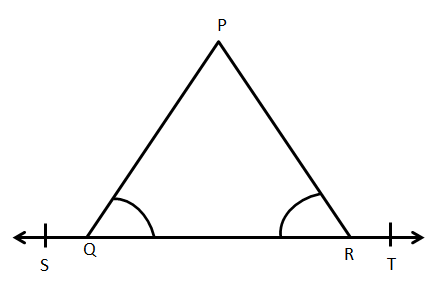
If \[\angle PQR = \angle PRQ\]
Then prove that \[\angle PQS = \angle PRT\]


Answer
458.1k+ views
Hint: Here, we will use the property of linear pairs to find the value of the given angles. Since, the given angles are equal, we will equate their value. After equating and cancelling out the like terms, we will find that \[\angle PQS = \angle PRT\], hence, proving the given condition.
Complete step-by-step answer:
We know that by the property of linear pair,
\[\angle PQR + \angle PQS = 180^\circ \]
Subtracting \[\angle PQS\] on both the sides, we get
\[ \Rightarrow \angle PQR = 180^\circ - \angle PQS\]…………………………………………….\[\left( 1 \right)\]
Similarly, by the property of linear pair,
\[\angle PRQ + \angle PRT = 180^\circ \]
Subtracting \[\angle PRT\] on both the sides, we get
\[ \Rightarrow \angle PRQ = 180^\circ - \angle PRT\]……………………………………………….\[\left( 2 \right)\]
But, according to the question, it is given that \[\angle PQR = \angle PRQ\]
Hence, equating \[\left( 1 \right)\] and \[\left( 2 \right)\], we get,
\[180^\circ - \angle PQS = 180^\circ - \angle PRT\]
Cancelling out \[180^\circ \]from both sides, we get
\[ \Rightarrow - \angle PQS = - \angle PRT\]
Again, cancelling out the negative sign from both sides, we get
\[ \Rightarrow \angle PQS = \angle PRT\]
Hence, proved.
Therefore, if \[\angle PQR = \angle PRQ\] then by linear pair, \[\angle PQS = \angle PRT\]
Note: Linear pair is defined as the pair of adjacent angles which are formed when two lines intersect each other. The sum of angles in a linear pair is always supplementary i.e. the angles add up to \[180^\circ \]. Also, from the word ‘pair’ we can see, that linear pair consists of the sum of two adjacent angles only. In case, we find that three angles are in a linear pair and we know that their sum is \[180^\circ \], then also, we cannot state that these angles are \[180^\circ \]. In such a case, we add those three angles and write that; since, these three angles lie on a straight line, hence, their sum is \[180^\circ \]. This would be a more valid and accurate reason. Hence, for these types of questions, whenever the internal angles are given equal, we can make their external angles equal by using a linear pair.
Complete step-by-step answer:
We know that by the property of linear pair,
\[\angle PQR + \angle PQS = 180^\circ \]
Subtracting \[\angle PQS\] on both the sides, we get
\[ \Rightarrow \angle PQR = 180^\circ - \angle PQS\]…………………………………………….\[\left( 1 \right)\]
Similarly, by the property of linear pair,
\[\angle PRQ + \angle PRT = 180^\circ \]
Subtracting \[\angle PRT\] on both the sides, we get
\[ \Rightarrow \angle PRQ = 180^\circ - \angle PRT\]……………………………………………….\[\left( 2 \right)\]
But, according to the question, it is given that \[\angle PQR = \angle PRQ\]
Hence, equating \[\left( 1 \right)\] and \[\left( 2 \right)\], we get,
\[180^\circ - \angle PQS = 180^\circ - \angle PRT\]
Cancelling out \[180^\circ \]from both sides, we get
\[ \Rightarrow - \angle PQS = - \angle PRT\]
Again, cancelling out the negative sign from both sides, we get
\[ \Rightarrow \angle PQS = \angle PRT\]
Hence, proved.
Therefore, if \[\angle PQR = \angle PRQ\] then by linear pair, \[\angle PQS = \angle PRT\]
Note: Linear pair is defined as the pair of adjacent angles which are formed when two lines intersect each other. The sum of angles in a linear pair is always supplementary i.e. the angles add up to \[180^\circ \]. Also, from the word ‘pair’ we can see, that linear pair consists of the sum of two adjacent angles only. In case, we find that three angles are in a linear pair and we know that their sum is \[180^\circ \], then also, we cannot state that these angles are \[180^\circ \]. In such a case, we add those three angles and write that; since, these three angles lie on a straight line, hence, their sum is \[180^\circ \]. This would be a more valid and accurate reason. Hence, for these types of questions, whenever the internal angles are given equal, we can make their external angles equal by using a linear pair.
Recently Updated Pages
Questions & Answers - Ask your doubts

Master Class 11 Accountancy: Engaging Questions & Answers for Success

Master Class 11 Science: Engaging Questions & Answers for Success

Master Class 12 Economics: Engaging Questions & Answers for Success

Master Class 12 Maths: Engaging Questions & Answers for Success

Master Class 12 Biology: Engaging Questions & Answers for Success

Trending doubts
In Indian rupees 1 trillion is equal to how many c class 8 maths CBSE

How many ounces are in 500 mL class 8 maths CBSE

What are the 12 elements of nature class 8 chemistry CBSE

The first matrimonial alliance with the Rajput was class 8 social science CBSE

Right to vote is a AFundamental Right BFundamental class 8 social science CBSE

Application to your principal for the character ce class 8 english CBSE




